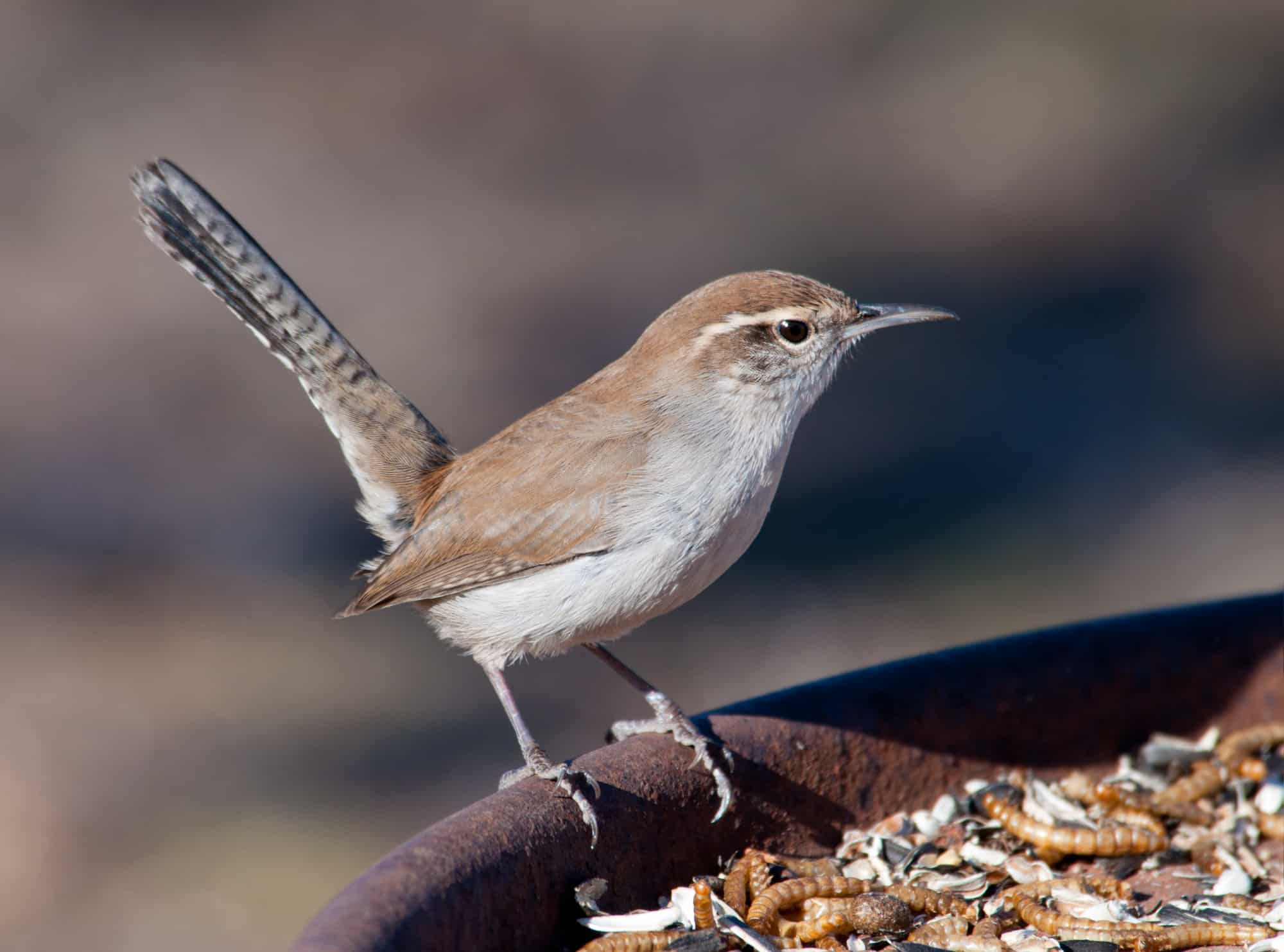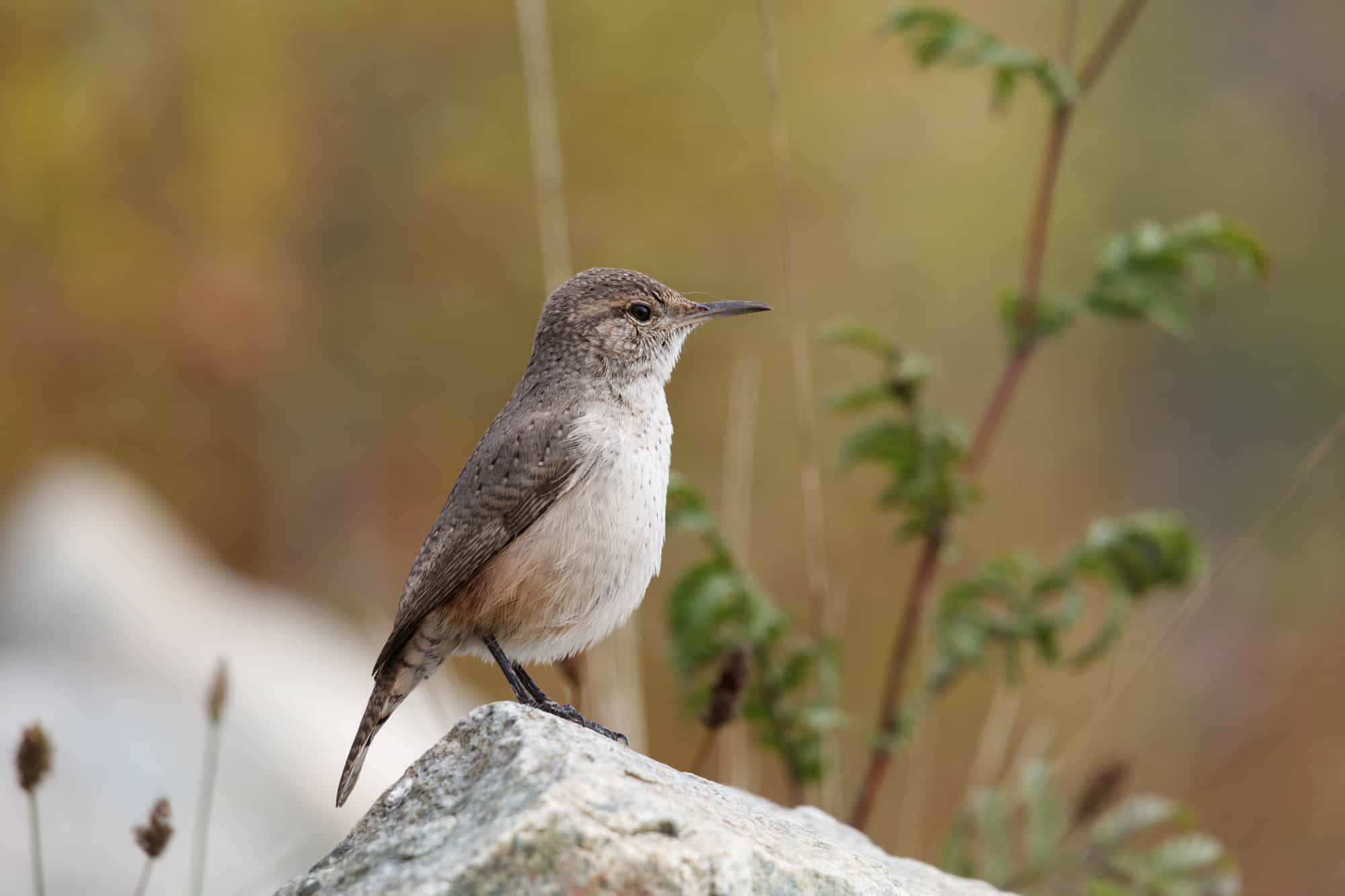Wrens. Tiny birds that seem ever-eager to make up for their small size with their energy and attitude. Sometimes only weighing as much as a couple of nickels, their booming songs can sometimes have you leaping out of your skin!
There are eleven wren species in North America, and seven of them can be found in Alabama. While only one of them is a truly common bird here, the rest add a fascinating array of diversity and provide a fun challenge for you to spot and identify as many as you can.
From the bold house wrens nesting in your old boots on the porch to shy sedge wrens, hiding in dense weedy meadows, there are endless opportunities to encounter these enchanting birds in the Southeastern States.
Let’s take a closer look, then, at Alabama’s wrens, starting with the most common, and finishing off with the rarest, most highly-prized species you can spot.
Seven Wrens in Alabama, Starting With the Most Common
Carolina Wren

- Scientific Name: Thryothorus ludovicianus
- Length: 4.7-5.5 in (12-14 cm)
- Weight: 0.6-0.8 oz (18-22 g)
- Wingspan: 9 in (23 cm)
As the dominant wren of the Southeastern States, Carolina wrens are by far and away the most common species in Alabama. According to bird watchers’ reports submitted on ebird.org, they’re seen by more than 40% of bird watchers in summer and winter!
Carolina wrens are particularly pretty little birds, with pale pinkish-orange undersides and long white eyebrows. Weighing about the same as 4 credit cards, they’re also one of the largest members of this diminutive family.
It can be great fun observing Carolina wrens in the backyard. As opportunistic nesters, they’ll make their homes in any type of container, from flowerpots to mailboxes, to old hats or boots hanging up in your garage!
Of course, they’ll also relish nestboxes if you provide them, and will use them for communal roosting during the colder months, too. Carolina wrens can also be attracted to backyard platforms and tube feeders by offering them mealworms, suet, or chopped nuts and seed during the winter.
House Wren

- Scientific Name: Troglodytes aedon
- Length: 4.3-5.1 in (11-13 cm)
- Weight: 0.3-0.4 oz (10-12 g)
- Wingspan: 5.9 in (15 cm)
House wrens might be widespread across North America, but they remain relatively uncommon in Alabama. The state is mainly a wintering ground for them, although small numbers of them do remain to breed in the north of the state, too.
Significantly smaller and more slender than Carolina wrens, house wrens in the eastern states can be either brownish or grayish in color, with darker barring across their wings and tail. They also lack the prominent eyebrow of many other species of wren.
The house wren is quite deserving of its name, spending plenty of time around human habitation, and often nesting in backyards. They’re not attracted to bird feeders but can be encouraged by leaving brush piles or weedy corners of the garden for them to forage about in.
House wrens are largely insectivorous, but they’ll also prey on grubs and spiders and will consume snail shells for calcium. They are noisy birds, so learning their metallic, warbling song is a good way to locate them!
Winter Wren

- Scientific Name: Troglodytes hiemalis
- Length: 3.1-4.7 in (8-12 cm)
- Weight: 0.3-0.4 oz (8-12 g)
- Wingspan: 4.7-6.3 in (12-16 cm)
Only slightly less common than the house wren in Alabama is the winter wren. Along with Pacific wrens, they’re the smallest members of the family and weigh less than two nickels!
Aside from their tiny size, winter wrens can be recognized by their dark color and round body shape. It’s this plump body that allows winter wrens to inhabit remarkably cold climates, and in summer, they migrate as far as Northern Canada for nesting.
In Alabama, you’ll only find winter wrens during the winter, when they may congregate in birdhouses to stay warm! Brush piles and overgrown corners of the garden will also encourage these woodland-loving birds to visit backyards.
The winter wren has a marvelous song that’s sung with impressive fervor for such a small bird. Listen out for a long, forceful series of high-pitched trills and warbles to alert you to their presence.
Marsh Wren

- Scientific Name: Cistothorus palustris
- Length: 3.9-5.5 in (10-14 cm)
- Weight: 0.3-0.5 oz (9-14 g)
- Wingspan: 5.9 in (15 cm)
The marsh wren is a small but mighty little bird with a fearsome attitude!
Although they remain discreetly hidden among marsh vegetation most of the time, they don’t take kindly to other birds in their vicinity and will sometimes raid the nests of their neighbors.
Because marsh wrens rarely leave the cover of waterlogged marsh habitats, they’re difficult birds to spot. Their no-nonsense attitude is reflected in their assertive, buzzing song, which lacks the charm of many of their relatives.
You’ll only find marsh wrens in Southern Alabama during the winter, and you’ll probably need to make a dedicated trip to the marshland to see them. Take a good pair of binoculars and be prepared to wait for these secretive little birds to emerge!
Sedge Wren

- Scientific Name: Cistothorus stellaris
- Length: 3.9-4.7 in (10-12 cm)
- Weight: 0.3oz (7-10 g)
- Wingspan: 4.7-5.5 in (12-14 cm)
Like marsh wrens, sedge wrens are tiny birds of damp habitats but prefer slightly drier domains than their raucous relatives. Whereas marsh wrens are found almost exclusively in vegetation amid standing water, sedge wrens will happily adopt a damp meadow as their home.
Sedge wrens are one of the rarest wren species in North America and are only seen by around one in five hundred bird watchers during the winter months in southern Alabama. In the summer, they fly to more northerly states and Canada for breeding.
To locate them, you’ll need to learn the sharp chatter that makes up their song. Some bird watchers will even try to imitate these sounds to coax these secretive birds out of their hiding places!
Bewick’s Wren

- Scientific Name: Thryomanes bewickii
- Length: 5.1 in (13 cm)
- Weight: 0.3-0.4 oz (8-12 g)
- Wingspan: 7 in (17.8cm)
Significantly rarer than the sedge wren in Alabama is Bewick’s wren. They only make very occasional appearances in the state and are treated as an accidental vagrant rather than a resident species.
Bewick’s wren is far from rare in America as a whole, though. They’re a common bird in the southwestern states and can be regularly seen as nearby as Arkansas.
In the unlikely event that a Bewick’s wren crosses your path in Alabama, you’re looking for a pretty little bird with a white-gray belly and white eyebrows. Their song is a mixture of tuneful whistles and noisy trills and buzzes.
Since Bewick’s wren numbers have been declining in the east, be sure to report any sightings of this bird to a local birding authority, such as the Alabama Ornithological Society.
Rock Wren

- Scientific Name: Salpinctes obsoletus
- Length: 4.9-5.9 in (12.5-15 cm)
- Weight: 0.5-0.6 oz (15-18 g)
- Wingspan: 8.7-9.4 in (22-24 cm)
The only other wren you could conceivably see in Alabama is the rock wren, but you’d be very lucky! Since they were last seen in the state in 2012, you’d be the first to see them here in over a decade.
Rock wrens are another species that are more common in the drier southwestern states. They are paler than other wrens, and have a longer bill than any other wren on our list.
If you were to see a rock wren, it’d likely be in a rocky landscape, using its long bill to search for food. They also have a lovely habit of bouncing up and down as they sing their sharp, stark song.
Conclusion
Wrens are birds with wonderful character, and it can be very rewarding to get to know them better.
Whether you’re an Alabama resident or just passing through the state, you’ll almost certainly come across at least one of these endearing birds in the Yellowhammer state.
As for other birds in Alabama, there are more than 400 species to enjoy! From red-tailed hawks, and summer tanagers, to northern flickers and cedar waxwings, the state is jam-packed with bird-watching opportunities that we explore in detail in our guide to the most iconic birds of Alabama.

